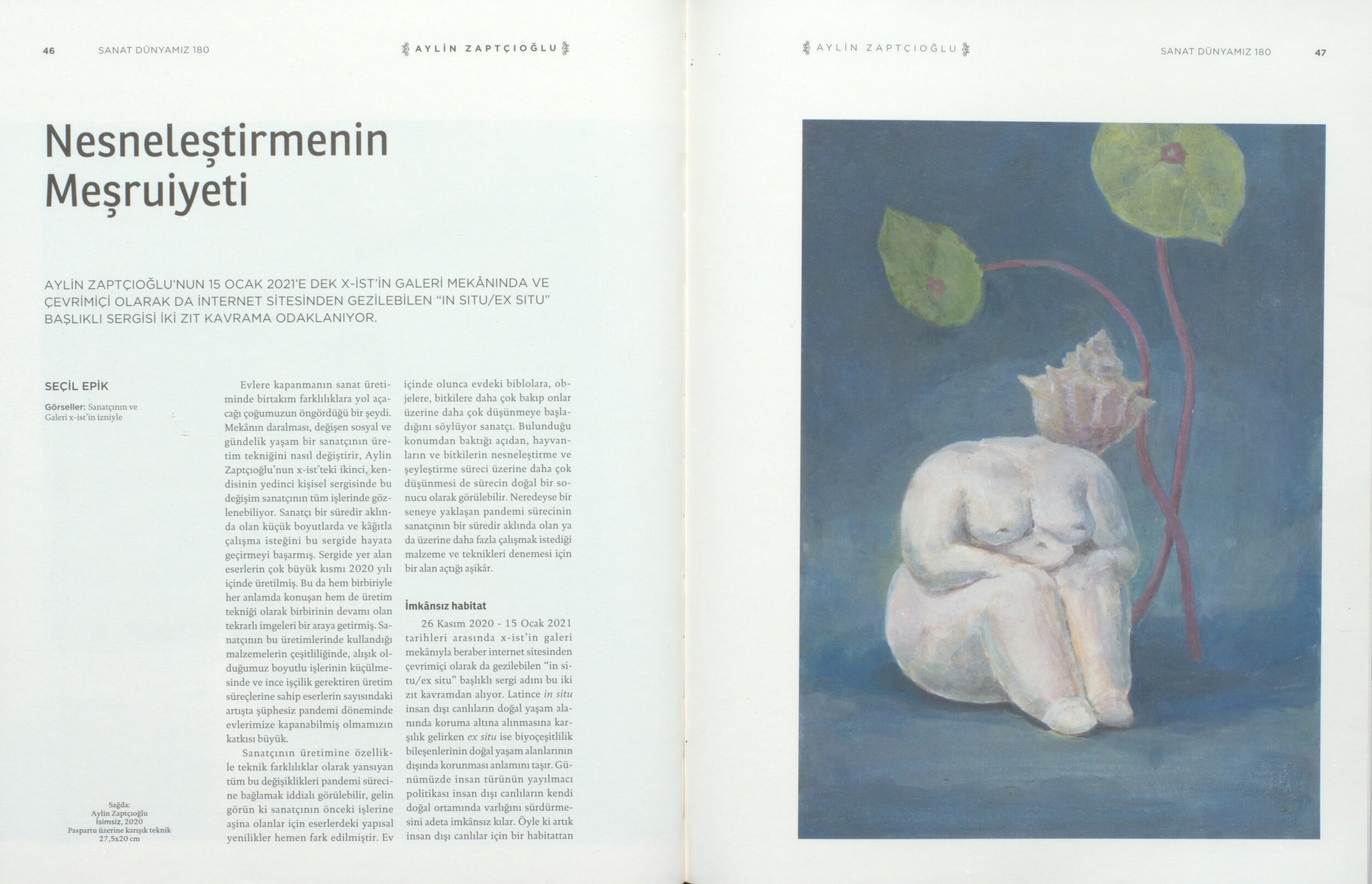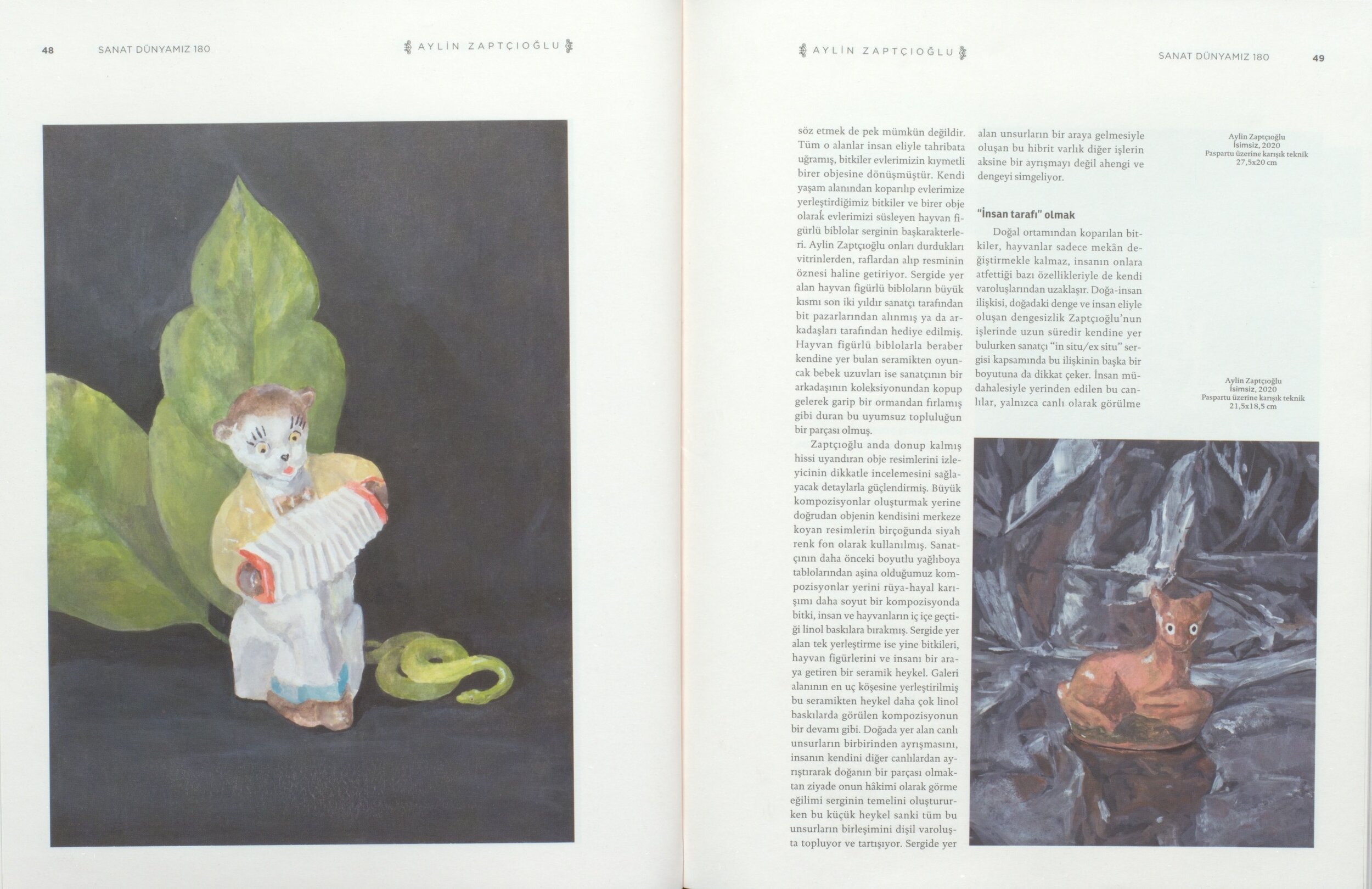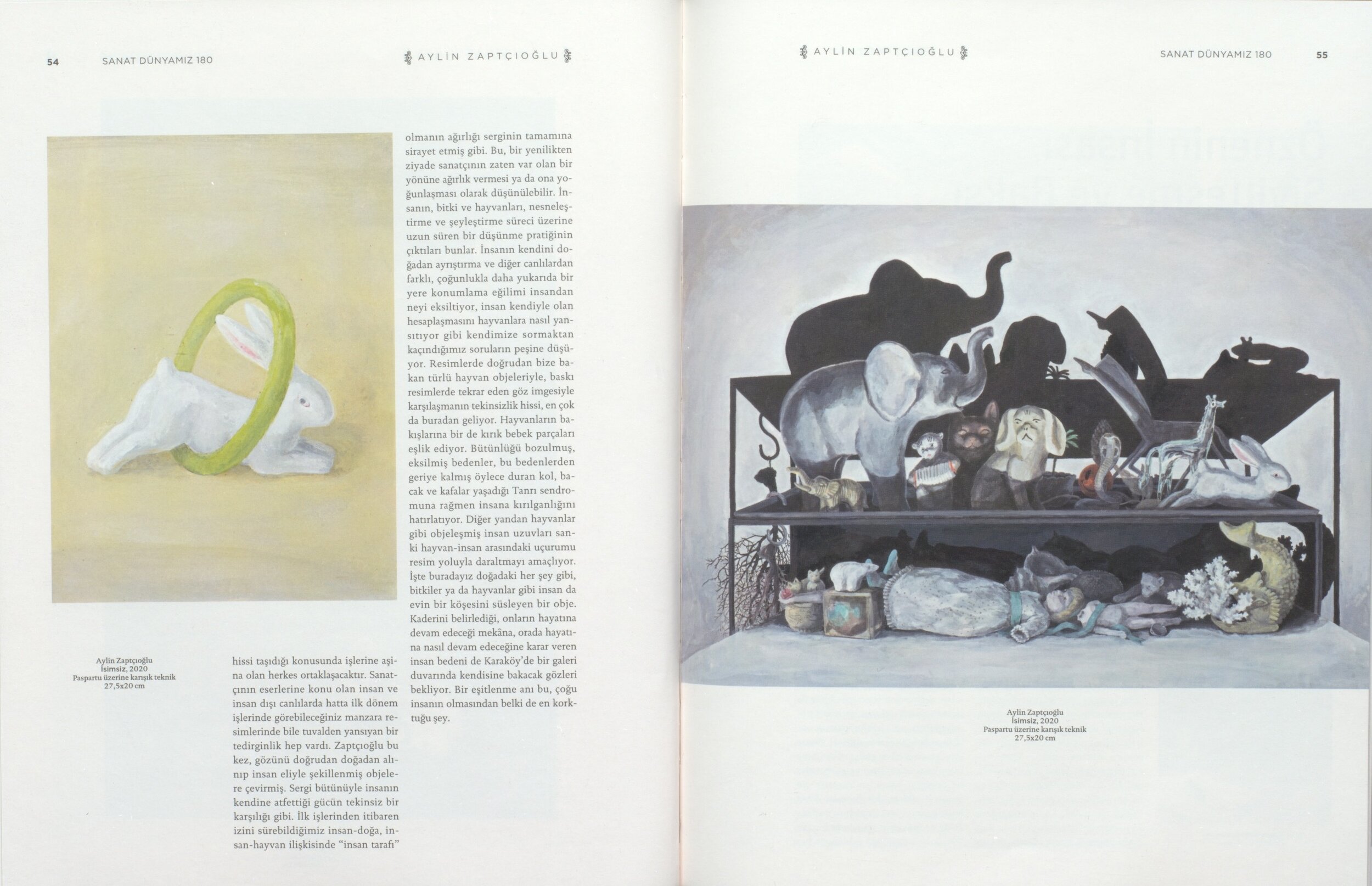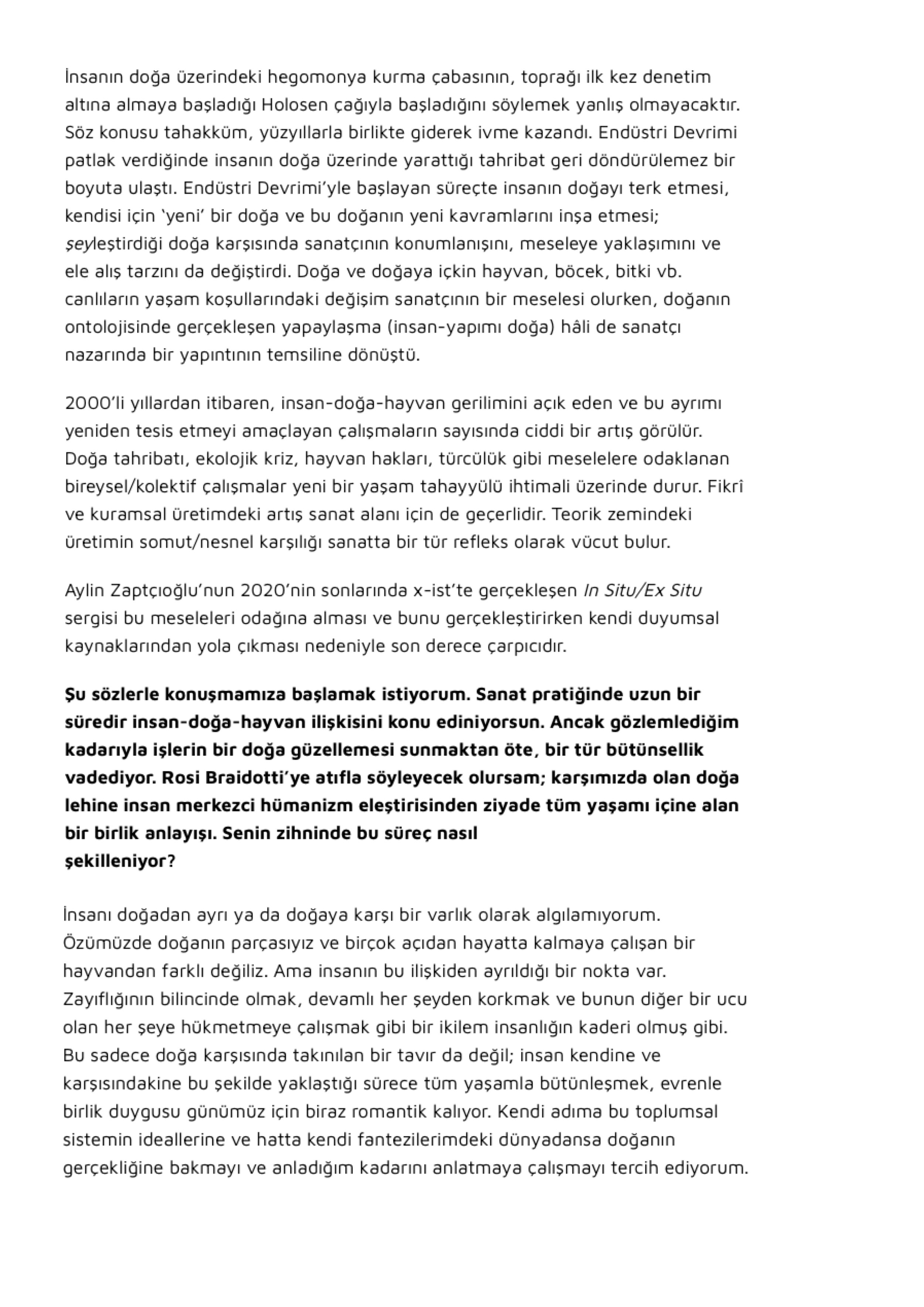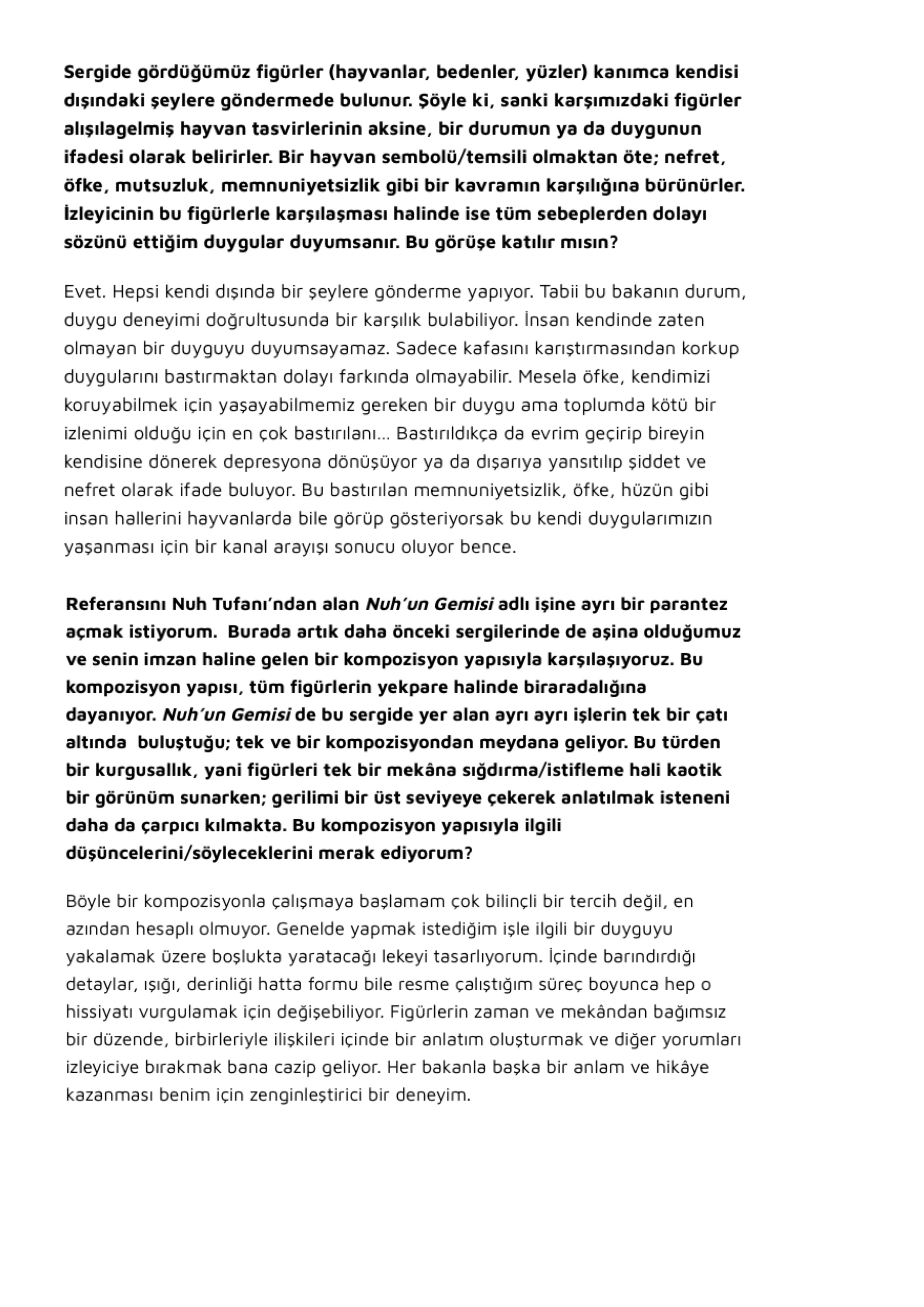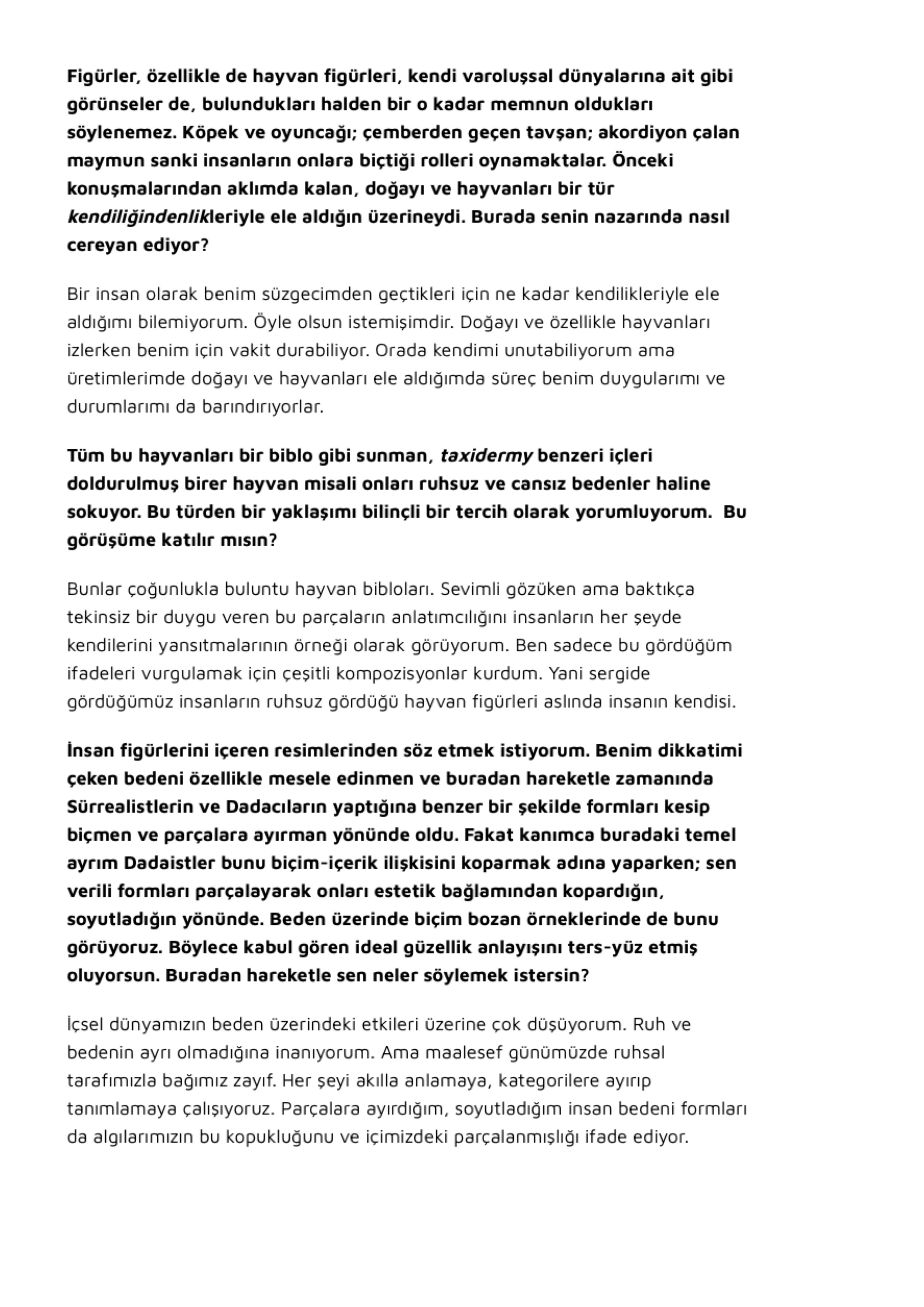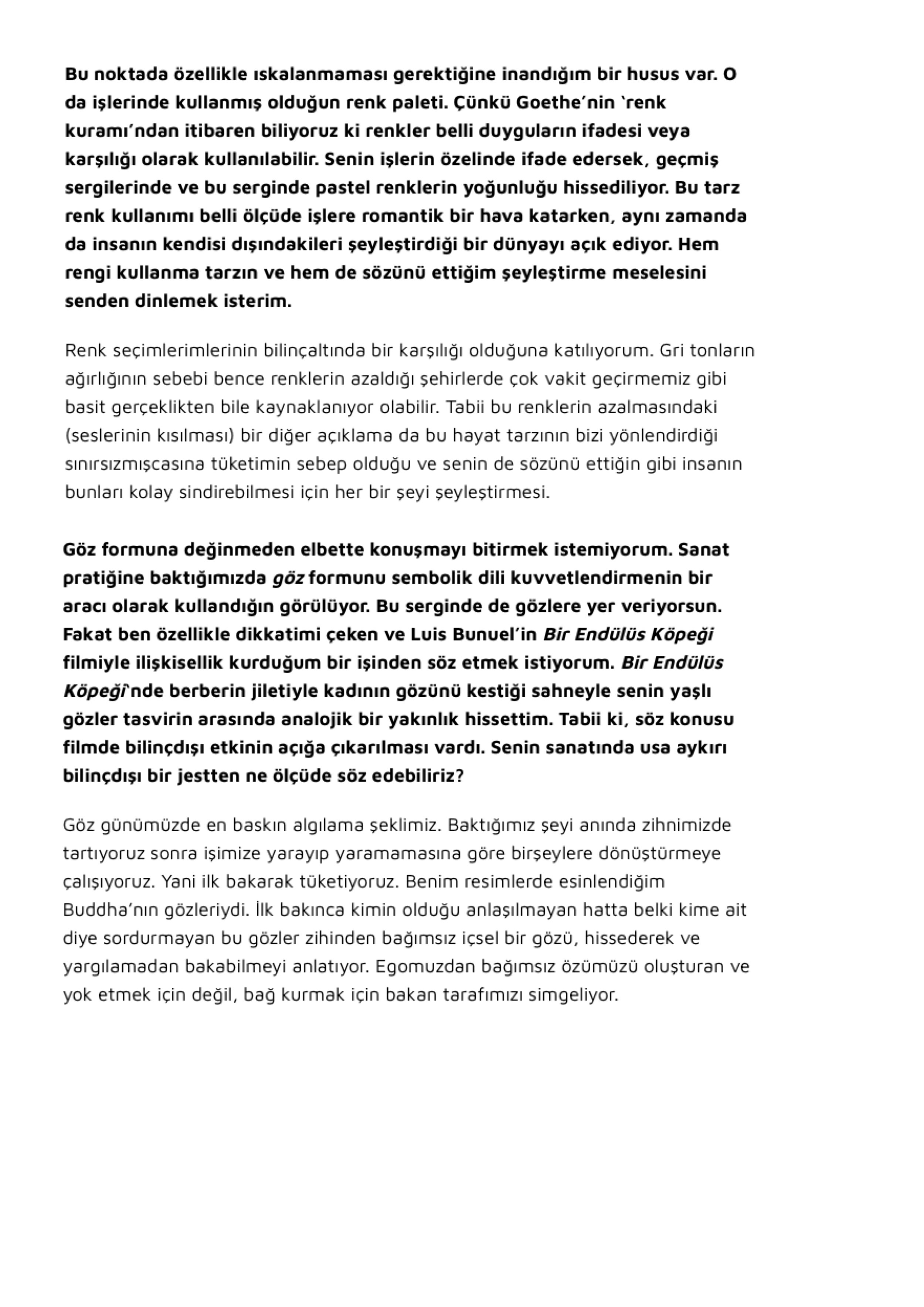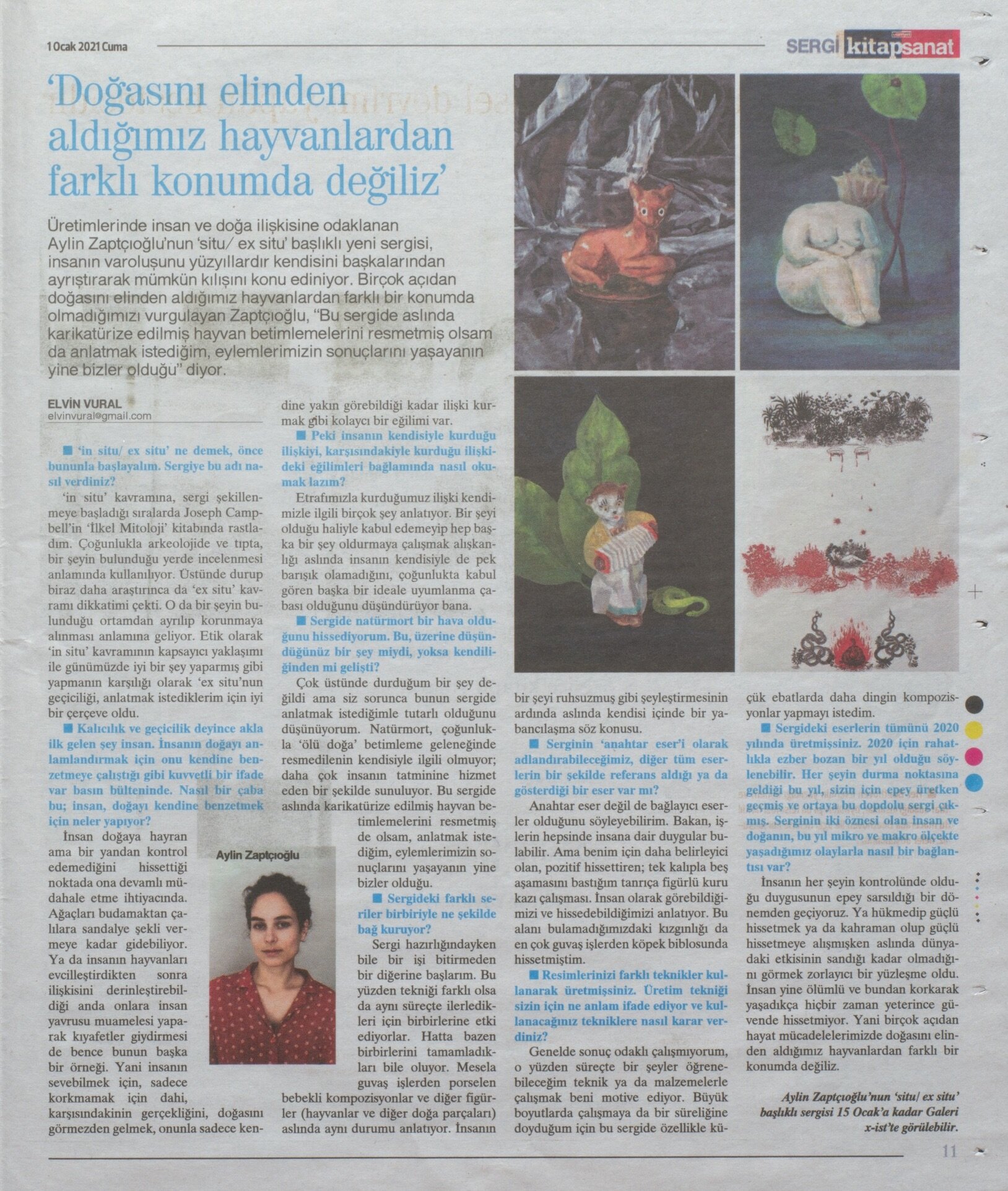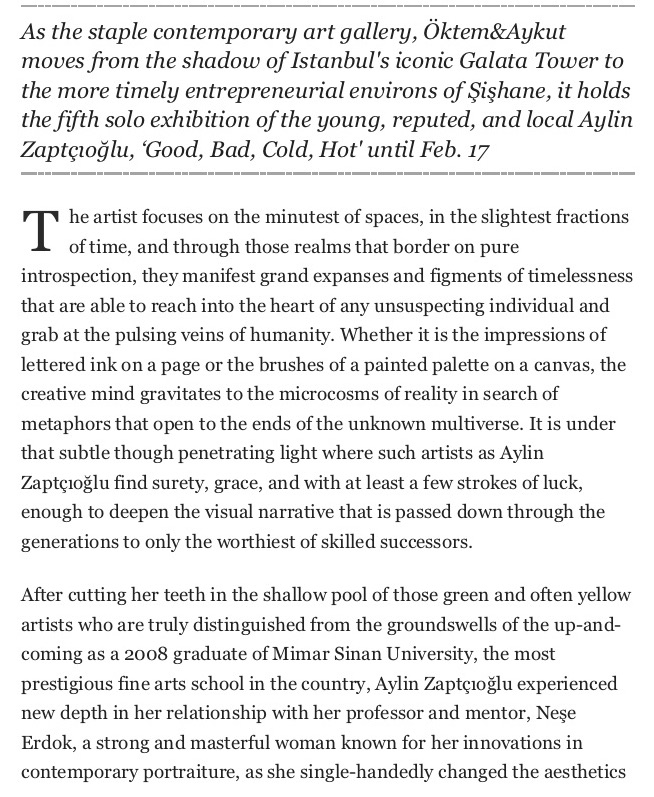Aylin Zaptcioglu, 1985
Lives and works in İstanbul, Turkey
Education
2008 -Mimar Sinan Fine Arts Academy , Painting, İstanbul
2007 -Bologna Fine Arts Academy , Bologna, Italy
Solo Exhibitions
2011 - Evin Art Gallery, İstanbul
2013 - Evin Art Gallery, İstanbul
2014 - 'Possibilities' , Evin Art Gallery, İstanbul
2016 - 'Fest and Feast' , Evin Art Gallery, İstanbul
2018 - 'Good, Bad, Cold, Hot' , Oktem & Aykut Gallery, İstanbul
2019 - ‘Interrupted Cycle’ , x-ist Gallery, İstanbul
2020 - ‘In Situ/ Ex Situ’ , x-ist Gallery, İstanbul
2023 - ‘I love you/ love me’ , x-ist Gallery, İstanbul
Group Exhibitions
2005 - Ipek Ahmet Merey painting competition, Istanbul
2006 - Nuri İyem Resim painting competition,Istanbul
2006 - 32nd Dyo Painting competition, Istanbul
2007 - 'Mail Art for Bike' painting exhibition, Bologna
2007 - Türk Kalp Vakfı painting competition, Istanbul
2009 - Artist 2009, 19th Istanbul Art Fair
2009 -Summer group exhibition, Beyoglu Akademililer, Istanbul
2009 - International Ex Libris competition, 'Forest of Utopia', Bodio Lomnago, Italy
2009 - 7th International Mexican Bienalle Ex Libris competition 'El Burro', Zacatecas, Mexico
2010 - 5th International Ex Libris competition, “The Celestial Sphere” , Bodio Lomnago, Italy
2010 -'Young Masters' painting exhibition, Besiktas Contemporary Art Gallery, Istanbul
2010 - Young Artists auction, Alif Art, İstanbul
2010 - Artist 2010, 20th İstanbul Art Fair
2012 - Summer group exhibition , Evin Art Gallery, İstanbul
2013 - Artist 2013, 23rd İstanbul Art Fair
2014 - Group exhibition, Evin Art Gallery, İstanbul
2014 - Artist 2014, 24th İstanbul Art Fair
2014 - Summer group exhibition, Evin Art Gallery, İstanbul
2015 - Group exhibition, Evin Art Gallery, İstanbul
2015 - Summer exhibition, Bashaques Alacati Art Gallery, Cesme
2015 - Artist 2015, 25th İstanbul Art Fair
2016 - Group exhibition, Evin Art Gallery, İstanbul
2018 - 'Chimera’ group exhibition, x-ist Gallery, İstanbul
2019 - ‘Paper’, Pilevneli Gallery, İstanbul
2019 - ‘Arada Bir Seyyah’ , Space Debris Art, İstanbul
2019 - Contemporary Istanbul ‘19, İstanbul
2019 - x-plore vol III, x-ist Gallery, İstanbul
2019 - Printed, Mixer, Istanbul
2019 - ‘Altı Üstü’ , O’art, İstanbul
2020 - ’At the end of the day’ , OMM, Eskisehir
2020 - Artweeks İstanbul
2020 - Contemporary İstanbul ‘20
2021 - ‘Yeşilmişik’ , Atelier Marvy, İzmir
2021 - Artweeks İstanbul
2021 - Contemporary İstanbul ‘21
2022 - CI Bloom , İstanbul
2022 - Artweeks İstanbul
2023 - ‘İstikrarlı Hayaller’ , Meteor Balat Kültürevi, Bursa
2023 - ‘Splash! ‘, x-İst Gallery & Casa Dell’Arte, Bodrum
2023 - O’Art 10.Yıl ‘Onunla’ , Cocoon Fisekhane , İstanbul
2023 - Uzak Yakın vol. 1 , İzmir Resim Heykel Müzesi Kulturpark Sanat Galerisi , İzmir
2023 - Artweeks , İstanbul
2024 - CI Bloom , İstanbul
2024 - Artshow , Art galleries United , x-İst Gallery, İstanbul
2024 - ‘Siyah ve Yaz ‘, x-İst Gallery & Casa Dell’Arte, Bodrum
2024 - Artweeks, İstanbul
2024 - 'New Lands’ , Arkas Sanat Alacati, Izmir
2025 - ‘Walls Embraced’, x-ist Gallery & Simurg-Inn, Canakkale
2025 - ‘Ferahfeza’ , OMM, Eskisehir
İNTERRUPTED CYCLE
We Are Almost There
I was on the same spot where I was waiting everyday and took the bus that did not yet have its share of the commuting crowd at the end of the day. I sat next to the window. I must have fallen asleep because when I opened my eyes there was nobody in the empty bus that had the lights on. None of the passengers had noticed that I was there and apparently even the bus driver had not bothered to wake me up. When I stepped out in order to understand where I was realized that I was somewhere that did not resemble the neighbourhoods that I passed by everyday on the same route. There was no living being except for the bushes
on the abandoned clearing where the bus had parked. A feeling of silence was prevailing even among the sparse grass on the ground. I started to
feel uneasy. I began to walk to find out where I was and to find somebody who could show me the way. After walking on the road illuminated by the moonlight for a while, I noticed a couple of eyes looking at me from afar. When I was walking towards these eyes with the hope that they would belong to somebody who might inform me, a feeling that something was going wrong overtook me. Passing through the pathways among the bushes and coming closer to the eyes ahead, I realized that there was something strange about it. When I fully approached them and realized that the eyes I’d seen belonged to a mask placed on the grass, I surrendered to a creepy feeling full of loneliness and uneasiness that might be felt when touching a dead animal. Everything that I touched was dull and lifeless. During the long and tiring walk, I was followed by flower and ivy-strewn sculptures, bodies that cannot find their heads and masks that cannot find their bodies. There were tons of questions in my mind. For example, how do we understand whether a form that we see from distance is alive or not? If it is
a sculpture, do the moss, ivies and flowers that wrap around it revive it? Or do they enable it to be considered as alive? Also a creature, which is standing still and seems to be frozen but breathes? Is life only real when we can communicate? What are the limits of this communication; is it only what we feel? While my mind was busy with all of these, I sat to
have a rest next to the bushes illuminated by the moonlight. Although I was aware of the severity of the situation, the tranquility of the surroundings was oddly peaceful. Just when I began to slowly accept the situation that I was in, a jackal coming out of the cave opposite, started to walk slowly towards me. Without coming too close, it stood on its hindlegs and put out its hand. It stayed in that position for a long time. It was as if all the living beings were petrifying behind the bushes and becoming part of the composition created by nature. What I could only do was to adapt to it. One of the unique abilities that humanity can brag about was the ability to adapt, after all. The dawn was breaking and
I had already gotten used to double-headed sculptures, marble heads standing on the tree separately from their bodies and everything that looked alive but didn’t breath and didn’t show any signs of life although breathing. I was not even surprised when the dog that appeared suddenly standing on the plant-strewn staircase with no clear way out did not move although it was breathing. The stairs was inviting me upstairs. When I climbed one by one, I found myself in front of a studio door. There was fresh smell of paint coming from inside. I rang the bell and a young woman greeted me. As we’re passing by the hallway to the living room, I see a painting of a cat blind in one eye staring at me next to an agave plant. The main characters of a world that was extremely familiar, were greeting me on the canvases in the studio. In Aylin Zaptçıoğlu’s paintings, the ‘living ones’ posing in the form of sculptures and the sculptures looking like as if they will begin moving soon determine the starting and endpoint of the world that the artist has created. The figures each creating a composition on their own sometimes pose for the audience and sometimes play games of which rules they determine. The flowers and ivies around become part of the beings standing there for a long time. Cutting at one point the cycle she deals with in her paintings, Zaptçıoğlu interferes in that moment and documents it secretly. On the other hand, in the scenes that have been set up by means of a wide-angle perspective, there are bushes, mountains or borders enclosed by wire fences on the surfaces creating the background. Skyscrapers that seem to appear all of a sudden or the factory covered in smoke in the background; and when we go from the movement towards the back, the visually calm composition slightly opens the doors of this dual world. What is going on in that tranquility is part of that partly uncanny and partly peaceful world where double-headed animals exist. This world is the utopia where the artist presents her stream of subconsciousness in an uncensored way.
Where there is the sun there is also the shadow within the natural functioning of the universe. Accordingly, the exhibition is set up on the principle of yin and yang. Although light and dark toned paintings are distinguished by their colours, the dominant melancholic atmosphere in each of them serves as a binder between the works. The paintings are, in a sense, a method of dealing with the idea of ‘losing’. The exhibition “Interrupted Cycle” in general takes off from this idea of transformation. Transformation exists in accordance with the order of the universe; man dies, the body merges with the soil, the soil becomes the plant. In Zaptçıoğlu’s paintings, we cannot distinguish whether the figures turn into plants or the plants into human beings or the human
beings into animals. Human memory also works similarly; we remember the images in an altered way.
Our memory is shaped by connotations. And sometimes we do some things randomly in the moment that we live in. The actions that we automatically do without thinking eliminate the awareness in our daily acts. Such as the limbs lost in the fog in the artist’s paintings: We know that our arm exists but our body does not make its existence felt each moment, however, we feel its absence in an extremely strong way. This unconscious state frequently draws attention in Zaptçıoğlu’s painting. A
figure posing in front is unaware of what’s going on behind or uninterested in extraordinary situations around it. The figures are also often disconnected from the audience. Except for the main characters alone in the center; the animals, half-animals, human beings and sculptures that provide the integrity of the painting are unaware of the existence of an audience and in an adapted position in their own nature.
There are several methods of expressing a subject in a pictorial language. You might think within concepts and proceed in a more planned way or you might follow a more expressionist method and trust your instincts. On the other hand, there’s an element in contemporary art the existence or necessity of which is not being discussed; one can call it the ‘soul’. One can describe and write about the elements such as the technical and conceptual perspective and the symbolism that makes a painting an artwork. But the soul of the painting is a more personal, intangible and indefinable element beyond all that. The transformation process of an idea into an artwork is not random; imagination and aesthetics step in. This is exactly what Zaptçıoğlu captures in the works that she creates by taking off from the concepts such as symbolism and Eastern philosophy; ‘the soul of painting’.
İdil Deniz Türkmen


